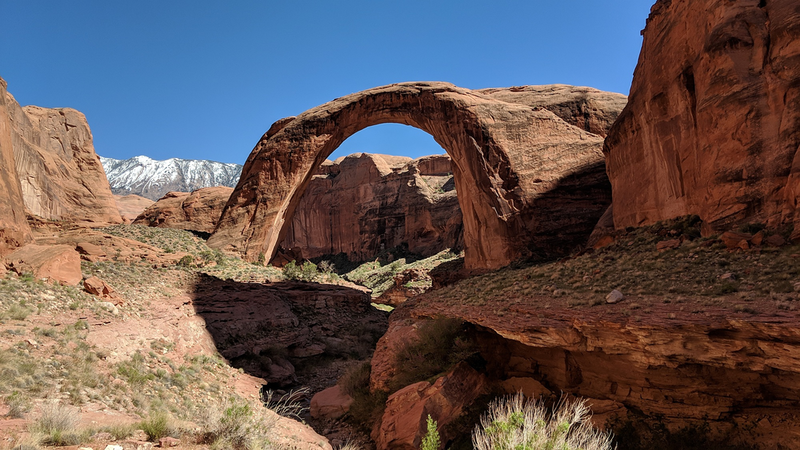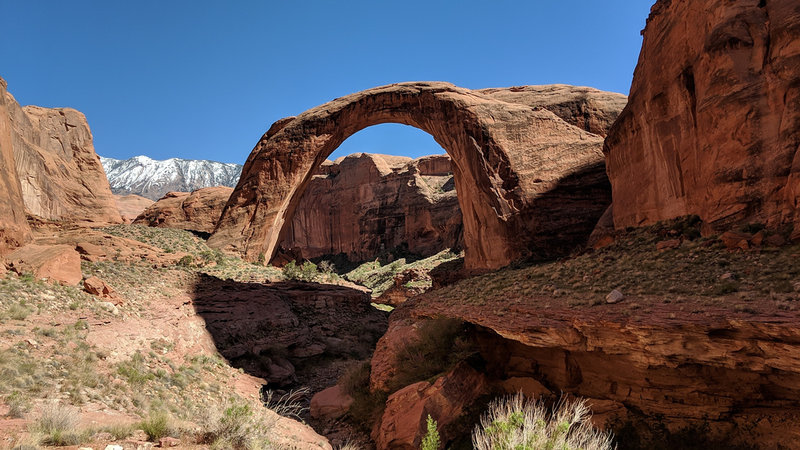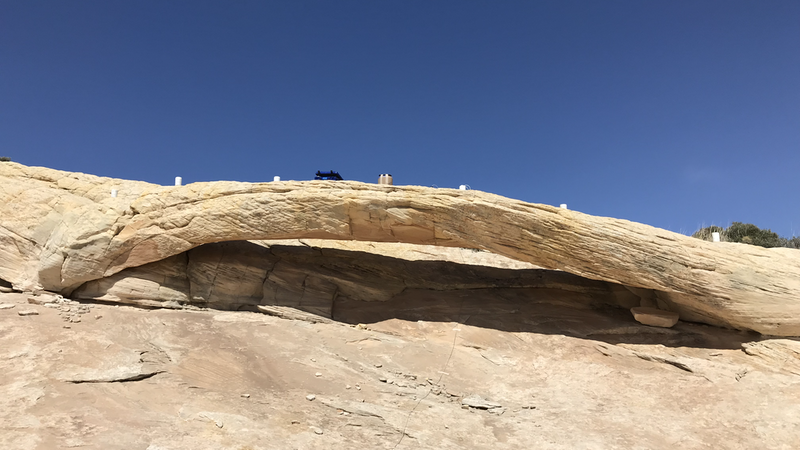The Geologic Toll of Helicopter Flights
At a whopping 290 feet tall, the dusky red sandstone arch known as Rainbow Bridge National Monument casts an imposing shadow over Utah’s Glen Canyon. By land, this ancient icon of the American West and sacred Native American site is accessible only by a 3- to 4-day hike through rocky terrain. Most of its 85,000 annual visitors instead observe the arch by boat or by helicopter. But researchers are worried that the flybys, which number in the tens per day, could put the arch, and others like it, in danger. At the Fall meeting of the American Geophysical Union (AGU) in San Francisco, Riley Finnegan of the University of Utah, Salt Lake City, reported that the low-frequency sound waves produced by helicopters can magnify the natural vibrations of arches 100-fold, potentially weakening these culturally valuable resources and shortening their lifespans.
“We have over 6000 arches documented around [Utah] and an entire national park dedicated to how great they are. We want to make sure that we aren’t inadvertently affecting the health of these really precious features,” Finnegan says.
Dozens of arches have collapsed in the last two decades, including Wall Arch and Rainbow Arch, which both sat in Utah’s Arches National Park. These collapses destroy irreplaceable natural wonders and endanger tourists. None of the recent arch collapses is attributable to helicopter flights. But aerial tours have increased over Glen Canyon and, in particular, Rainbow Bridge, and there are also more flights over other parks and monuments. So the Native American Consultation Committee, which advises the National Park Service on their management of this monument, asked researchers to look into the problem.
In their study, Finnegan and her colleagues monitored the velocity of oscillations—the maximum speed with which the surface moved when vibrating—in five of Utah’s arches. Across the top of each arch, the team placed seismometers and geophones, devices that convert movements into a voltage that the team then recorded. They also monitored the intensity of the helicopter-produced, low-frequency sound waves, known as infrasound, at each location.
“We simply set seismometers on top of the feature that we want to measure and then leave it alone. [The devices] then tell us how the vibrations change over time,” says Finnegan. She explains that this noninvasive approach is important to avoid damaging the arches.
The team monitored between two and nine helicopter flybys for the different arches over the course of the study. For each flyby, the team measured intense bursts of infrasound, up to 100 decibels in magnitude. This high-intensity, low-frequency sound—around 13 Hz and multiples thereof—would be inaudible to humans. But for the arches, which naturally oscillate at frequencies in this range, “it’s like being at a live concert,” Finnegan says.
Looking at the seismic data taken during these periods, the team determined that the arches reverberate with high-speed vibrations, with the shape of the ripples looking like the standing waves produced on guitar strings after they are plucked. At Squint Arch, where the velocity of tremors was highest, the team measured vibrations with a velocity of 0.1 mm/s, a level 100 times greater than the few-micrometers-per-second vibrations caused by Earth’s background rumble. Finnegan thinks that only earthquakes of magnitude 4 could cause vibrations like those induced by helicopters, and they occur "maybe once in a hundred years.”
While the velocities of the measured vibrations appear high, predictions indicate they are too small to cause “instantaneous” damage to the arches, Finnegan says. The team observed no external damage to the structures from their experiments, which involved tourist flights, as well as specially arranged flybys. But that doesn’t mean that the arches go unharmed. The repeated bursts of high-intensity vibrations could be weakening the arches’ rocks, for example, by lengthening cracks that are already present, Finnegan says. The team plans to investigate the possibility that vibrations lengthen cracks using computer models.
For instantaneous damage, Finnegan predicts that the velocity of the vibrations would need to be at least 2 mm/s. While those levels were not seen here, Finnegan says that past tests measured helicopter-induced vibrations in pinnacles—isolated towers of rock—with velocities of twice this threshold.
–Katherine Wright
Katherine Wright is a Senior Editor for Physics.







